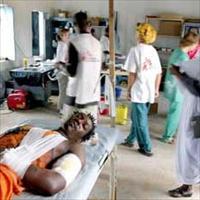MADAGASCAR: Rift Valley Fever hits island

"An outbreak has been confirmed; it will be a big
challenge to contain," Nestor Ndayimirije, Inter-Country Epidemiologist at
the UN World Health Organisation's (WHO) Eastern and Southern Africa office,
told IRIN.
The MoH said 59 cases had been positively identified by
the Pasteur Institute of Madagascar, part of a global network devoted to
medical issues and epidemiological screening in developing countries.
RVF is a viral disease that primarily affects animals
but can also infect humans, so even when the disease has been removed from
human populations "you still have to control the animal side,"
Ndayimirije explained.
RVF is usually well-established in animal populations by
the time the first human cases are observed - the Ministry of Agriculture first
reported cases among livestock on 9 April.
According to a WHO statement, the human cases were
recorded the Alaotra Mangoro, Analamanga, Itasy, Vakinakaratra and Anosy
regions in the East of the Indian Ocean
island.
A call for help
In an effort to contain the outbreak, Malagasy authorities
have established an inter-ministerial committee to oversee the response and
have requested assistance from the WHO, the UN Food and Agricultural
Organisation (FAO) and the World Organisation for Animal Health (OIE).
A joint mission of WHO, FAO and OIE representatives to
support Malagasy efforts was expected to be in the country by 23 April,
Ndayimirije said.
Meanwhile, Malagasy authorities have implemented control
measures such as case management, surveillance, social mobilisation, provision of
medicines, and prevention and strengthening of hospital infection control.
The vast majority of RVF infections in humans result
from direct or indirect contact with the blood or organs of infected animals.
To date, no human-to-human transmission of RVF has been documented, according
to the WHO.
Human infections have also resulted from the bites of
infected mosquitoes and RVF has commonly been associated with unusually heavy
rainfall and flooding. Madagascar
is just coming out of a particularly
wet rainy reason: earlier this year cyclones Fame and Ivan brought powerful
winds, heavy rains and flooding that affected over 330,000 people, of whom
190,000 lost their homes.
"While some infected people experience no
detectable symptoms, others develop flu-like fever, muscle pain, headaches,
joint pain, vomiting, loss of appetite and sensitivity to light. In more severe
cases patients can also experience lesions in their eyes, neurological
problems, liver impairment and haemorrhagic fever symptoms, including
widespread bleeding," the WHO statement said.
RVF was generally confined to Sub-Saharan Africa until
outbreaks were reported in Saudi Arabia
and subsequently in Yemen
in 2000.
 Back and Next - Back and Next
Back and Next - Back and Next See Also - See Also
See Also - See Also